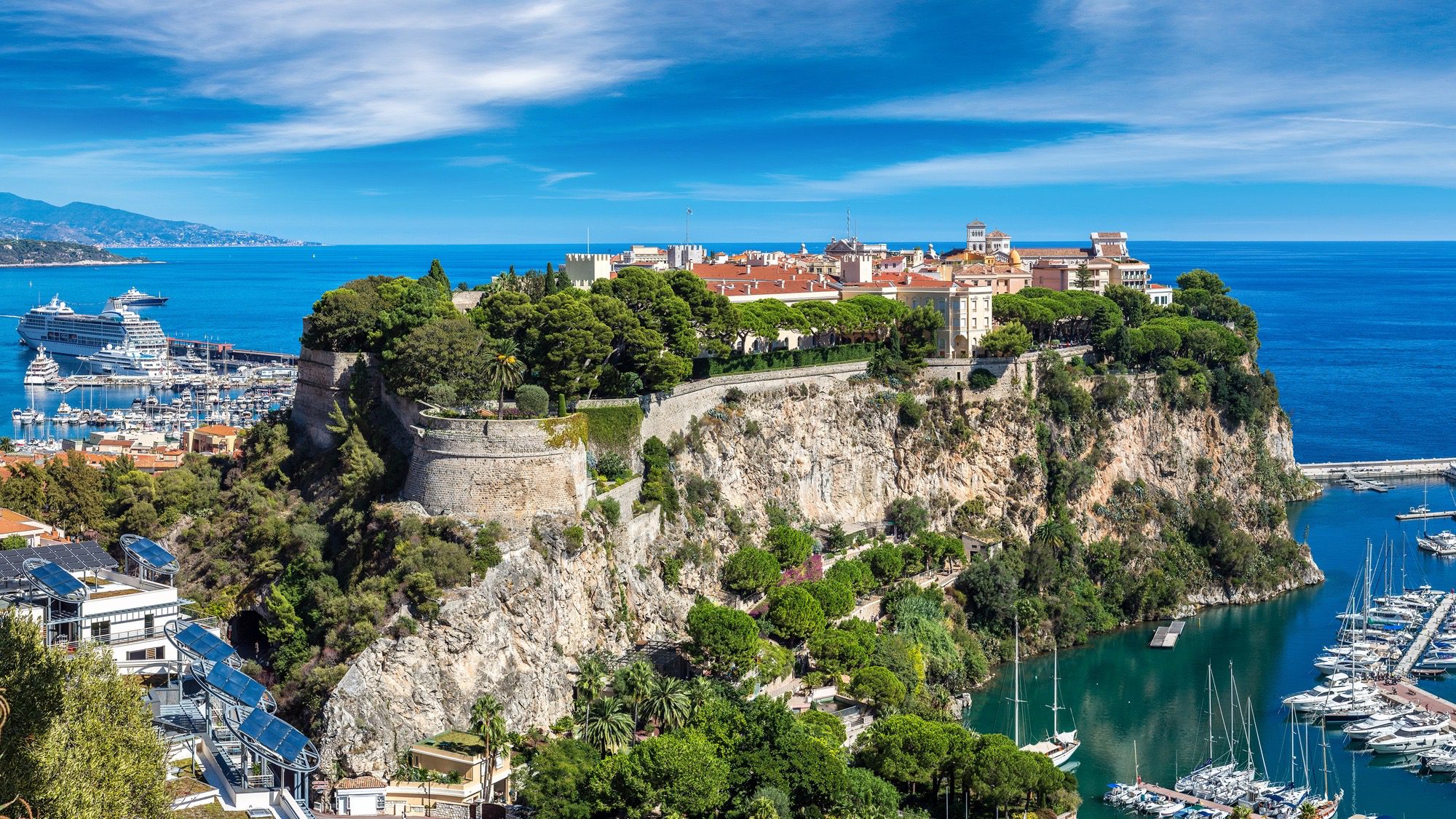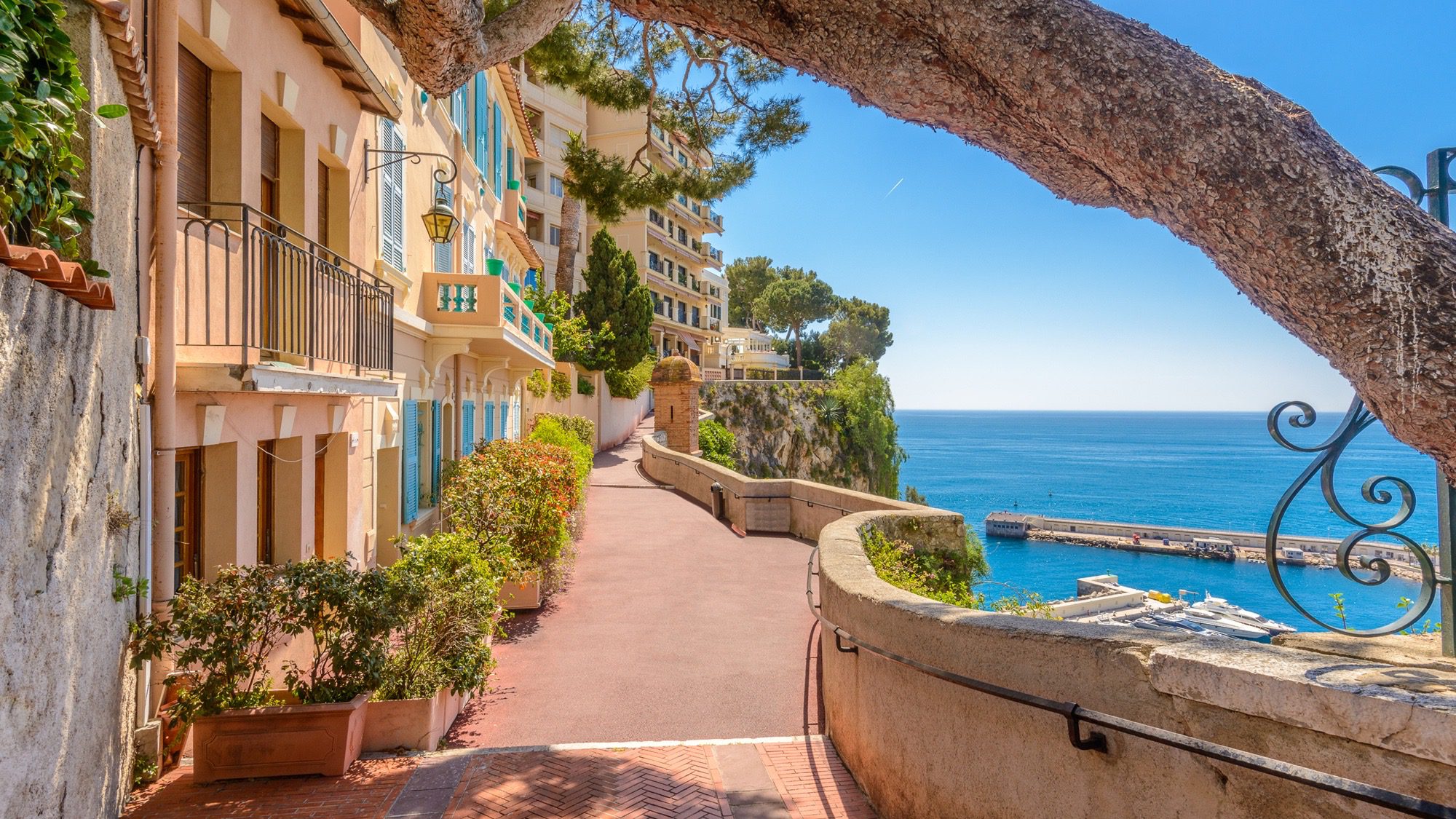MONACO-VILLE
Perched on a rocky promontory overlooking the Mediterranean Sea, Monaco-Ville – also known as “Le Rocher” – embodies the historic heart of the Principality of Monaco. Its picturesque streets, centuries-old architecture, and preserved atmosphere attract thousands of visitors every year in search of authenticity and cultural discoveries. Over the centuries, this historic district has witnessed major events and welcomed countless travelers, all captivated by its unique character.
A millennial past to discover step by step
Le Rocher takes its name from its unique geographical location: a rocky plateau overlooking the sea that, early on, caught attention for its strategic defensive position. Founded in the Middle Ages around a fortress, Monaco’s old town served for centuries as an outpost to control maritime access and protect the coast from invasions. Over time, the medieval fortifications expanded and transformed, gradually giving way to an urban ensemble combining charm and heritage.
Walking through the narrow streets of Monaco-Ville, you are immersed in a timeless atmosphere. The colorful facades, sometimes adorned with arcades or traditional shutters, reflect the architectural diversity of successive eras. Here, a relic from the Middle Ages stands next to a Renaissance-style building. This richness can be attributed to the influence of the Grimaldi dynasty, which has ruled the Principality since the 13th century and shaped Monaco’s appearance through alliances and political changes.
The museums and historical sites scattered throughout Monaco-Ville enhance this journey through time. Some recount the Principality’s tumultuous history, while others highlight its cultural influence across Europe. Every alley holds a story, an architectural detail, or a commemorative plaque that tells a piece of Monaco’s rich history. Art lovers, heritage enthusiasts, or those simply seeking unique walks will find plenty to satisfy their curiosity and wonder in this medieval district.


Iconic monuments and a breathtaking panorama
No visit to Monaco-Ville is complete without stopping at the Prince’s Palace, an undeniable symbol of Monegasque sovereignty. Built on the foundations of a Genoese fortress, this official residence of the Prince of Monaco impresses with its Renaissance architecture and historical significance. Watching the changing of the guard, held daily at 11:55 a.m., is a ritual that attracts crowds and showcases the loyalty of the Prince’s Carabiniers to the ruling family. The palace interior, accessible during certain times of the year, features lavishly decorated ceremonial rooms, reflecting the splendor enjoyed by the Grimaldi dynasty for centuries.
Not far from the palace is the Cathedral of Monaco, also known as “Cathedral of Our Lady of the Immaculate Conception,” which captivates visitors with its Roman-Byzantine style. Built at the end of the 19th century using white stone from La Turbie, it houses the tombs of Princes and Princesses, a testament to the Grimaldi family’s deep connection to this place of reflection. Fans of sacred music will enjoy attending services accompanied by the cathedral’s organ, a true masterpiece of sound craftsmanship.
The Oceanographic Museum, founded by Prince Albert I, is another must-see. Perched on a cliff, it overlooks the Mediterranean and offers a stunning view of the sea. Inside, hundreds of marine species swim in vast tanks, while interactive exhibits showcase efforts to preserve the oceans and their biodiversity. The building’s exterior architecture, with its ornate details and richly sculpted facade, adds to the unique charm of Le Rocher.
Beyond these key landmarks, Monaco-Ville offers numerous panoramic viewpoints of the Principality and the sea, particularly from the Rampe Major or the ramparts of Le Rocher. Whether admiring Port Hercule, the Monte-Carlo district, or the azure horizon, thesenatural lookouts provide perfect stops to take in the scenery and breathe in the sea air.

Village atmosphere, Monegasque traditions, and local flavors
One of Monaco-Ville’s defining features is its almost village-like atmosphere, which contrasts with the hustle and bustle of Monte-Carlo or La Condamine. Here, visitors can stroll through pedestrian streets, exploring family-run shops, souvenir boutiques, and small shaded squares where locals gather. Restaurants, often housed in historic buildings, serve authentic Mediterranean cuisine inspired by Provençal and Italian flavors.
Throughout the year, Monaco-Ville comes alive with religious festivals and official celebrations. Among the most notable is the Corpus Christi festival, during which a solemn procession winds through the streets. On November 19, the Prince’s Day – Monaco’s national holiday – unites the population to celebrate the Principality’s heritage with ceremonies, parades, and fireworks. These occasions offer visitors the chance to experience local enthusiasm and share moments of conviviality with residents.
At the same time, Monaco-Ville is a hub for cultural exchanges, hosting temporary exhibitions, concerts, and performances in its various iconic venues. Monegasque traditions are thus preserved while embracing outside influences. This harmonious coexistence of ancient heritage and modernity gives Le Rocher a unique vitality, appealing to history enthusiasts and fans of relaxation and gastronomy alike.
Practical tips
To make the most of your visit to Monaco-Ville, it’s recommended to explore the area on foot, as most streets are closed to traffic. Additionally, the only road accessible to motor vehicles is strictly reserved for those registered in Monaco or the French department of Alpes-Maritimes. It’s advisable to reach Le Rocher by bus from other districts of the Principality or park at the Parking des Pêcheurs and use the elevator directly from the parking area to access Monaco-Ville.
Distances are short, but the streets can be steep; therefore, it’s advisable to wear comfortable clothing and sturdy shoes. Visiting in the early morning or late afternoon helps avoid the crowds of tourist excursions and offers softer light for photos. During high season, it’s best to book in advance if you plan to dine at one of the area’s restaurants.
In conclusion, Monaco-Ville is the historic and cultural heart of the Principality. With its millennial past, majestic monuments, vibrant traditions, and unique atmosphere, every corner of Le Rocher tells a part of Monaco’s story and offers a full immersion into the soul of this extraordinary territory. Whether you are an architecture enthusiast, a gastronomy lover, or simply curious to learn more about this small state on the French Riviera, Monaco-Ville is sure to enchant you. Let yourself be charmed by its picturesque streets and timeless ambiance: this is where the true heart of Monaco beats, and where the authenticity of a Principality proud of its heritage and looking confidently to the future resides.
